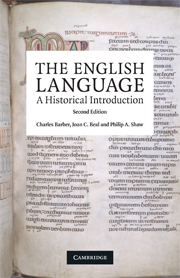Book contents
- Frontmatter
- Contents
- List of figures
- Preface to the second edition
- Preface to the first edition
- Map showing the counties of England
- 1 What is language?
- 2 The flux of language
- 3 The Indo-European languages
- 4 The Germanic languages
- 5 Old English
- 6 Norsemen and Normans
- 7 Middle English
- 8 Early Modern English
- 9 Late Modern English
- 10 English as a world language
- 11 English today and tomorrow
- Notes and suggestions for further reading
- Bibliography
- Index
1 - What is language?
- Frontmatter
- Contents
- List of figures
- Preface to the second edition
- Preface to the first edition
- Map showing the counties of England
- 1 What is language?
- 2 The flux of language
- 3 The Indo-European languages
- 4 The Germanic languages
- 5 Old English
- 6 Norsemen and Normans
- 7 Middle English
- 8 Early Modern English
- 9 Late Modern English
- 10 English as a world language
- 11 English today and tomorrow
- Notes and suggestions for further reading
- Bibliography
- Index
Summary
It is language, more obviously than anything else, that distinguishes humankind from the rest of the animal world. Humans have also been described as tool-making animals; but language itself is the most remarkable tool that they have invented, and is the one that makes most of the others possible. The most primitive tools, admittedly, may have come earlier than language: the higher apes sometimes use sticks as elementary tools, and even break them for this purpose. But tools of any greater sophistication demand the kind of human co-operation and division of labour which is hardly possible without language. Language, in fact, is the great machine-tool which makes human culture possible.
Other animals, it is true, communicate with one another, or at any rate stimulate one another to action, by means of cries. Many birds utter warning calls at the approach of danger; some animals have mating-calls; apes utter different cries to express anger, fear or pleasure. Some animals use other modes of communication: many have postures that signify submission, to prevent an attack by a rival; hive-bees indicate the direction and distance of honey from the hive by means of the famous bee-dance; dolphins seem to have a communication system which uses both sounds and bodily posture. But these various means of communication differ in important ways from human language. Animals' cries are not articulate. This means, basically, that they lack structure.
- Type
- Chapter
- Information
- The English LanguageA Historical Introduction, pp. 1 - 30Publisher: Cambridge University PressPrint publication year: 2009

